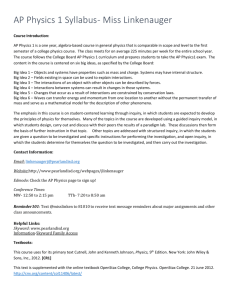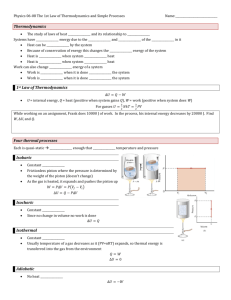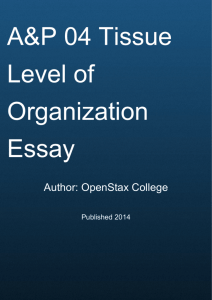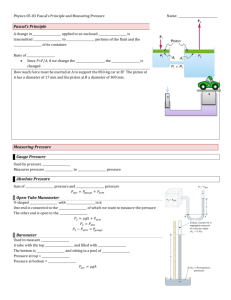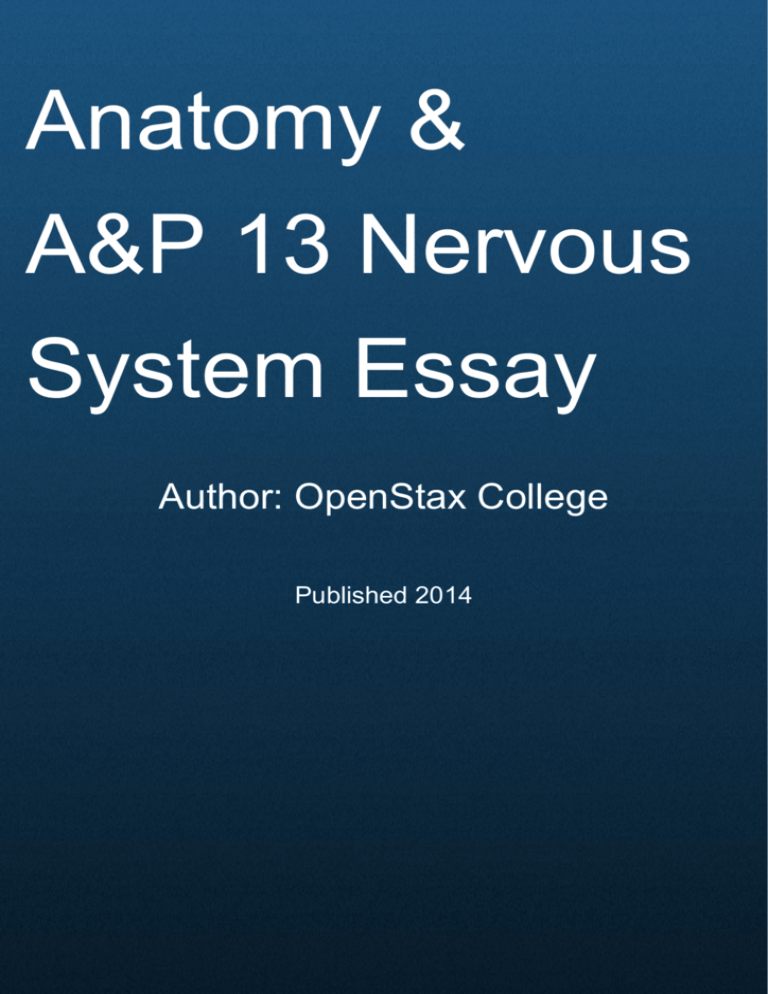
Cover Page
Anatomy &
A&P 13 Nervous
System Essay
Author: OpenStax College
Published 2014
About Us
Powered by QuizOver.com
The Leading Online Quiz & Exam Creator
Create, Share and Discover Quizzes & Exams
http://www.quizover.com
(2) Powered by QuizOver.com - http://www.quizover.com
QuizOver.com is the leading online quiz & exam creator
Copyright (c) 2009-2015 all rights reserved
Disclaimer
All services and content of QuizOver.com are provided under QuizOver.com terms of use on an "as is" basis,
without warranty of any kind, either expressed or implied, including, without limitation, warranties that the provided
services and content are free of defects, merchantable, fit for a particular purpose or non-infringing.
The entire risk as to the quality and performance of the provided services and content is with you.
In no event shall QuizOver.com be liable for any damages whatsoever arising out of or in connection with the use
or performance of the services.
Should any provided services and content prove defective in any respect, you (not the initial developer, author or
any other contributor) assume the cost of any necessary servicing, repair or correction.
This disclaimer of warranty constitutes an essential part of these "terms of use".
No use of any services and content of QuizOver.com is authorized hereunder except under this disclaimer.
The detailed and up to date "terms of use" of QuizOver.com can be found under:
http://www.QuizOver.com/public/termsOfUse.xhtml
(3) Powered by QuizOver.com - http://www.quizover.com
QuizOver.com is the leading online quiz & exam creator
Copyright (c) 2009-2015 all rights reserved
eBook Content License
OpenStax College. Anatomy & Physiology, OpenStax-CNX Web site.
http://cnx.org/content/col11496/1.6/, Jun 11, 2014
Creative Commons License
Attribution-NonCommercial-NoDerivs 3.0 Unported (CC BY-NC-ND 3.0)
http://creativecommons.org/licenses/by-nc-nd/3.0/
You are free to:
Share: copy and redistribute the material in any medium or format
The licensor cannot revoke these freedoms as long as you follow the license terms.
Under the following terms:
Attribution: You must give appropriate credit, provide a link to the license, and indicate if changes were made. You
may do so in any reasonable manner, but not in any way that suggests the licensor endorses you or your use.
NonCommercial: You may not use the material for commercial purposes.
NoDerivatives: If you remix, transform, or build upon the material, you may not distribute the modified material.
No additional restrictions: You may not apply legal terms or technological measures that legally restrict others
from doing anything the license permits.
(4) Powered by QuizOver.com - http://www.quizover.com
QuizOver.com is the leading online quiz & exam creator
Copyright (c) 2009-2015 all rights reserved
4. Chapter: A&P 13 Nervous System Essay
1. A&P 13 Nervous System Essay Questions
(5) Powered by QuizOver.com - http://www.quizover.com
QuizOver.com is the leading online quiz & exam creator
Copyright (c) 2009-2015 all rights reserved
4.1.1. Watch this animation (http://openstaxcollege.org/l/braindevel) to e...
Author: OpenStax College
Watch this animation (http://openstaxcollege.org/l/braindevel) to examine the development of the brain, starting
with the neural tube.
As the anterior end of the neural tube develops, it enlarges into the primary vesicles that establish the forebrain,
midbrain, and hindbrain.
Those structures continue to develop throughout the rest of embryonic development and into adolescence.
They are the basis of the structure of the fully developed adult brain.
How would you describe the difference in the relative sizes of the three regions of the brain when comparing the
early (25th
embryonic day) brain and the adult brain? (http://openstaxcollege.org/l/hugebrain) in which the author explores
the current understanding of why this happened.
•
The three regions (forebrain, midbrain, and hindbrain) appear to be approximately equal in size when
they are first established, but the midbrain in the adult is much smaller than the others-suggesting
that it does not increase in size nearly as much as the forebrain or hindbrain.
Check the answer of this question online at QuizOver.com:
Question: Watch this animation http://openstaxcollege OpenStax College Anatomy
(6) Powered by QuizOver.com - http://www.quizover.com
QuizOver.com is the leading online quiz & exam creator
Copyright (c) 2009-2015 all rights reserved
4.1.2. Watch this video (http://openstaxcollege.org/l/whitematter) to lear...
Author: OpenStax College
Watch this video (http://openstaxcollege.org/l/whitematter) to learn about the white matter in the cerebrum that
develops during childhood and adolescence.
This is a composite of MRI images taken of the brains of people from 5 years of age through 20 years of age,
demonstrating how the cerebrum changes.
As the color changes to blue, the ratio of gray matter to white matter changes.
The caption for the video describes it as "less gray matter," which is another way of saying "more white matter."
If the brain does not finish developing until approximately 20 years of age, can teenagers be held responsible for
behaving badly?
•
This is really a matter of opinion, but there are ethical issues to consider when a teenager's behavior
results in legal trouble.
Check the answer of this question online at QuizOver.com:
Question: Watch this video http://openstaxcollege OpenStax College Anatomy
(7) Powered by QuizOver.com - http://www.quizover.com
QuizOver.com is the leading online quiz & exam creator
Copyright (c) 2009-2015 all rights reserved
4.1.3. Watch this video (http://openstaxcollege.org/l/basalnuclei1) to lea...
Author: OpenStax College
Watch this video (http://openstaxcollege.org/l/basalnuclei1) to learn about the basal nuclei (also known as the
basal ganglia), which have two pathways that process information within the cerebrum.
As shown in this video, the direct pathway is the shorter pathway through the system that results in increased
activity in the cerebral cortex and increased motor activity.
The direct pathway is described as resulting in "disinhibition" of the thalamus.
What does disinhibition mean? What are the two neurons doing individually to cause this?
•
Both cells are inhibitory. The first cell inhibits the second one. Therefore, the second cell can no
longer inhibit its target. This is disinhibition of that target across two synapses.
Check the answer of this question online at QuizOver.com:
Question: Watch this video http://openstaxcollege OpenStax College Anatomy
(8) Powered by QuizOver.com - http://www.quizover.com
QuizOver.com is the leading online quiz & exam creator
Copyright (c) 2009-2015 all rights reserved
4.1.4. Watch this video (http://openstaxcollege.org/l/basalnuclei2) to lea...
Author: OpenStax College
Watch this video (http://openstaxcollege.org/l/basalnuclei2) to learn about the basal nuclei (also known as the
basal ganglia), which have two pathways that process information within the cerebrum.
As shown in this video, the indirect pathway is the longer pathway through the system that results in decreased
activity in the cerebral cortex, and therefore less motor activity.
The indirect pathway has an extra couple of connections in it, including disinhibition of the subthalamic nucleus.
What is the end result on the thalamus, and therefore on movement initiated by the cerebral cortex?
•
By disinhibiting the subthalamic nucleus, the indirect pathway increases excitation of the globus
pallidus internal segment.
That, in turn, inhibits the thalamus, which is the opposite effect of the direct pathway that disinhibits
the thalamus.
Check the answer of this question online at QuizOver.com:
Question: Watch this video http://openstaxcollege OpenStax College Anatomy
(9) Powered by QuizOver.com - http://www.quizover.com
QuizOver.com is the leading online quiz & exam creator
Copyright (c) 2009-2015 all rights reserved
4.1.5. Watch this video (http://openstaxcollege.org/l/graymatter) to learn...
Author: OpenStax College
Watch this video (http://openstaxcollege.org/l/graymatter) to learn about the gray matter of the spinal cord that
receives input from fibers of the dorsal (posterior) root and sends information out through the fibers of the ventral
(anterior) root.
As discussed in this video, these connections represent the interactions of the CNS with peripheral structures for
both sensory and motor functions.
The cervical and lumbar spinal cords have enlargements as a result of larger populations of neurons.
What are these enlargements responsible for?
•
There are more motor neurons in the anterior horns that are responsible for movement in the limbs.
The cervical enlargement is for the arms, and the lumbar enlargement is for the legs.
Check the answer of this question online at QuizOver.com:
Question: Watch this video http://openstaxcollege OpenStax College Anatomy
(10) Powered by QuizOver.com - http://www.quizover.com
QuizOver.com is the leading online quiz & exam creator
Copyright (c) 2009-2015 all rights reserved
4.1.6. Compared with the nearest evolutionary relative, the chimpanzee, th...
Author: OpenStax College
Compared with the nearest evolutionary relative, the chimpanzee, the human has a brain that is huge.
At a point in the past, a common ancestor gave rise to the two species of humans and chimpanzees.
That evolutionary history is long and is still an area of intense study.
But something happened to increase the size of the human brain relative to the chimpanzee.
Read this article (http://openstaxcollege.org/l/hugebrain) in which the author explores the current understanding of
why this happened.
According to one hypothesis about the expansion of brain size, what tissue might have been sacrificed so energy
was available to grow our larger brain? Based on what you know
about that tissue and nervous tissue, why would there be a trade-off between them in terms of energy use?
•
Energy is needed for the brain to develop and perform higher cognitive functions.
That energy is not available for the muscle tissues to develop and function.
The hypothesis suggests that humans have larger brains and less muscle mass, and chimpanzees have the
smaller brains but more muscle mass.
Check the answer of this question online at QuizOver.com:
Question: Compared with the nearest evolutionary OpenStax College Anatomy Quest
(11) Powered by QuizOver.com - http://www.quizover.com
QuizOver.com is the leading online quiz & exam creator
Copyright (c) 2009-2015 all rights reserved
4.1.7. Watch this animation (http://openstaxcollege.org/l/bloodflow1) to s...
Author: OpenStax College
Watch this animation (http://openstaxcollege.org/l/bloodflow1) to see how blood flows to the brain and passes
through the circle of Willis before being distributed through the cerebrum.
The circle of Willis is a specialized arrangement of arteries that ensure constant perfusion of the cerebrum even in
the event of a blockage of one of the arteries in the circle.
The animation shows the normal direction of flow through the circle of Willis to the middle cerebral artery.
Where would the blood come from if there were a blockage just posterior to the middle cerebral artery on the left?
•
If blood could not get to the middle cerebral artery through the posterior circulation, the blood
would flow around the circle of Willis to reach that artery from an anterior vessel.
Blood flow would just reverse within the circle.
Check the answer of this question online at QuizOver.com:
Question: Watch this animation http://openstaxcollege OpenStax College Anatomy
(12) Powered by QuizOver.com - http://www.quizover.com
QuizOver.com is the leading online quiz & exam creator
Copyright (c) 2009-2015 all rights reserved
4.1.8. Watch this video (http://openstaxcollege.org/l/lumbarpuncture) that...
Author: OpenStax College
Watch this video (http://openstaxcollege.org/l/lumbarpuncture) that describes the procedure known as the lumbar
puncture, a medical procedure used to sample the CSF.
Because of the anatomy of the CNS, it is a relative safe location to insert a needle.
Why is the lumbar puncture performed in the lower lumbar area of the vertebral column?
•
The spinal cord ends in the upper lumbar area of the vertebral column, so a needle inserted lower than
that will not damage the nervous tissue of the CNS.
Check the answer of this question online at QuizOver.com:
Question: Watch this video http://openstaxcollege OpenStax College Anatomy
(13) Powered by QuizOver.com - http://www.quizover.com
QuizOver.com is the leading online quiz & exam creator
Copyright (c) 2009-2015 all rights reserved
4.1.9. Watch this animation (http://openstaxcollege.org/l/CSFflow) that sh...
Author: OpenStax College
Watch this animation (http://openstaxcollege.org/l/CSFflow) that shows the flow of CSF through the brain and
spinal cord, and how it originates from the ventricles and then spreads into the space within the meninges, where
the fluids then move into the venous sinuses to return to the cardiovascular circulation.
What are the structures that produce CSF and where are they found? How are the structures indicated in this
animation?
•
The choroid plexuses of the ventricles make CSF. As shown, there is a little of the blue color appearing
in each ventricle that is joined by the color flowing from the other ventricles.
Check the answer of this question online at QuizOver.com:
Question: Watch this animation http://openstaxcollege OpenStax College Anatomy
(14) Powered by QuizOver.com - http://www.quizover.com
QuizOver.com is the leading online quiz & exam creator
Copyright (c) 2009-2015 all rights reserved
4.1.10. Figure 13.20 If you zoom in on the DRG, you can see smaller satelli...
Author: OpenStax College
Figure 13.20 If you zoom in on the DRG, you can see smaller satellite glial cells surrounding the large cell bodies
of the sensory neurons.
From what structure do satellite cells derive during embryologic development?
•
Figure 13.20 They derive from the neural crest.
Check the answer of this question online at QuizOver.com:
Question: Figure 13.20 If you zoom in on the DRG OpenStax College Anatomy Quest
(15) Powered by QuizOver.com - http://www.quizover.com
QuizOver.com is the leading online quiz & exam creator
Copyright (c) 2009-2015 all rights reserved
4.1.11. Figure 13.22 To what structures in a skeletal muscle are the endone...
Author: OpenStax College
Figure 13.22 To what structures in a skeletal muscle are the endoneurium, perineurium, and epineurium
comparable?
•
Figure 13.22 The endoneurium surrounding individual nerve fibers is comparable to the endomysium
surrounding myofibrils, the perineurium bundling axons into fascicles is comparable to the perimysium
bundling muscle fibers into fascicles, and the epineurium surrounding the whole nerve is comparable
to the epimysium surrounding the muscle.
Check the answer of this question online at QuizOver.com:
Question: Figure 13.22 To what structures in a OpenStax College Anatomy Quest
(16) Powered by QuizOver.com - http://www.quizover.com
QuizOver.com is the leading online quiz & exam creator
Copyright (c) 2009-2015 all rights reserved
4.1.12. Visit this site (http://openstaxcollege.org/l/NYTmeningitis) to rea...
Author: OpenStax College
Visit this site (http://openstaxcollege.org/l/NYTmeningitis) to read about a man who wakes with a headache and a
loss of vision.
His regular doctor sent him to an ophthalmologist to address the vision loss.
The ophthalmologist recognizes a greater problem and immediately sends him to the emergency room.
Once there, the patient undergoes a large battery of tests, but a definite cause cannot be found.
A specialist recognizes the problem as meningitis, but the question is what caused it originally.
How can that be cured? The loss of vision comes from swelling around the optic nerve, which probably presented
as a bulge on the inside of the eye.
Why is swelling related to meningitis going to push on the optic nerve?
•
The optic nerve enters the CNS in its projection from the eyes in the periphery, which means that it
crosses through the meninges.
Meningitis will include swelling of those protective layers of the CNS, resulting in pressure on the
optic nerve, which can compromise vision.
Check the answer of this question online at QuizOver.com:
Question: Visit this site http://openstaxcollege OpenStax College Anatomy Quest
(17) Powered by QuizOver.com - http://www.quizover.com
QuizOver.com is the leading online quiz & exam creator
Copyright (c) 2009-2015 all rights reserved
4.1.13. Studying the embryonic development of the nervous system makes it e...
Author: OpenStax College
Studying the embryonic development of the nervous system makes it easier to understand the complexity of the
adult nervous system.
Give one example of how development in the embryonic nervous system explains a more complex structure in the
adult nervous system.
•
The retina, a PNS structure in the adult, grows from the diencephalon in the embryonic nervous system.
The mature connections from the retina through the optic nerve/tract are to the hypothalamus and
thalamus of the diencephalon, and to the midbrain, which developed directly adjacent to the diencephalon
as the mesencephalon in the embryo.
Check the answer of this question online at QuizOver.com:
Question: Studying the embryonic development of the OpenStax College Anatomy
(18) Powered by QuizOver.com - http://www.quizover.com
QuizOver.com is the leading online quiz & exam creator
Copyright (c) 2009-2015 all rights reserved
4.1.14. What happens in development that suggests that there is a special r...
Author: OpenStax College
What happens in development that suggests that there is a special relationship between the skeletal structure of
the head and the nervous system?
•
The neural crest gives rise to PNS structures (such as ganglia) and also to cartilage and bone of the
face and cranium.
Check the answer of this question online at QuizOver.com:
Question: What happens in development that suggests OpenStax College Anatomy
(19) Powered by QuizOver.com - http://www.quizover.com
QuizOver.com is the leading online quiz & exam creator
Copyright (c) 2009-2015 all rights reserved
4.1.15. Damage to specific regions of the cerebral cortex, such as through ...
Author: OpenStax College
Damage to specific regions of the cerebral cortex, such as through a stroke, can result in specific losses of
function.
What functions would likely be lost by a stroke in the temporal lobe?
•
The temporal lobe has sensory functions associated with hearing and vision, as well as being important
for memory.
A stroke in the temporal lobe can result in specific sensory deficits in these systems (known as
agnosias) or losses in memory.
Check the answer of this question online at QuizOver.com:
Question: Damage to specific regions of the cerebral OpenStax College Anatomy
(20) Powered by QuizOver.com - http://www.quizover.com
QuizOver.com is the leading online quiz & exam creator
Copyright (c) 2009-2015 all rights reserved
4.1.16. Why do the anatomical inputs to the cerebellum suggest that it can ...
Author: OpenStax College
Why do the anatomical inputs to the cerebellum suggest that it can compare motor commands and sensory
feedback?
•
A copy of descending input from the cerebrum to the spinal cord, through the pons, and sensory feedback
from the spinal cord and special senses like balance, through the medulla, both go to the cerebellum.
It can therefore send output through the midbrain that will correct spinal cord control of skeletal
muscle movements.
Check the answer of this question online at QuizOver.com:
Question: Why do the anatomical inputs to the OpenStax College Anatomy Quest
(21) Powered by QuizOver.com - http://www.quizover.com
QuizOver.com is the leading online quiz & exam creator
Copyright (c) 2009-2015 all rights reserved
4.1.17. Why can the circle of Willis maintain perfusion of the brain even i...
Author: OpenStax College
Why can the circle of Willis maintain perfusion of the brain even if there is a blockage in one part of the structure?
•
The structure is a circular connection of blood vessels, so that blood coming up from one of the
arteries can flow in either direction around the circle and avoid any blockage or narrowing of the
blood vessels.
Check the answer of this question online at QuizOver.com:
Question: Why can the circle of Willis maintain OpenStax College Anatomy Quest
(22) Powered by QuizOver.com - http://www.quizover.com
QuizOver.com is the leading online quiz & exam creator
Copyright (c) 2009-2015 all rights reserved
4.1.18. Meningitis is an inflammation of the meninges that can have severe ...
Author: OpenStax College
Meningitis is an inflammation of the meninges that can have severe effects on neurological function.
Why is infection of this structure potentially so dangerous?
•
The nerves that connect the periphery to the CNS pass through these layers of tissue and can be damaged
by that inflammation, causing a loss of important neurological functions.
Check the answer of this question online at QuizOver.com:
Question: Meningitis is an inflammation of the OpenStax College Anatomy Quest
(23) Powered by QuizOver.com - http://www.quizover.com
QuizOver.com is the leading online quiz & exam creator
Copyright (c) 2009-2015 all rights reserved
4.1.19. Why are ganglia and nerves not surrounded by protective structures ...
Author: OpenStax College
Why are ganglia and nerves not surrounded by protective structures like the meninges of the CNS?
•
The peripheral nervous tissues are out in the body, sometimes part of other organ systems.
There is not a privileged blood supply like there is to the brain and spinal cord, so peripheral
nervous tissues do not need the same sort of protections.
Check the answer of this question online at QuizOver.com:
Question: Why are ganglia and nerves not surrounded OpenStax College Anatomy
(24) Powered by QuizOver.com - http://www.quizover.com
QuizOver.com is the leading online quiz & exam creator
Copyright (c) 2009-2015 all rights reserved
4.1.20. Testing for neurological function involves a series of tests of fun...
Author: OpenStax College
Testing for neurological function involves a series of tests of functions associated with the cranial nerves.
What functions, and therefore which nerves, are being tested by asking a patient to follow the tip of a pen with
their eyes?
•
The contraction of extraocular muscles is being tested, which is the function of the oculomotor,
trochlear, and abducens nerves.
Check the answer of this question online at QuizOver.com:
Question: Testing for neurological function involves OpenStax College Anatomy
(25) Powered by QuizOver.com - http://www.quizover.com
QuizOver.com is the leading online quiz & exam creator
Copyright (c) 2009-2015 all rights reserved

